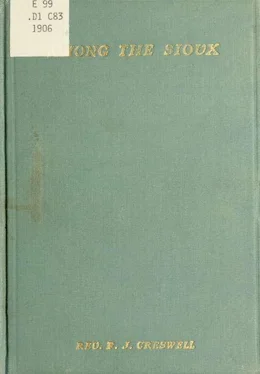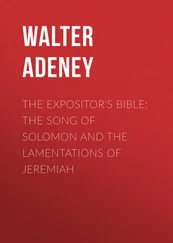Creswell, J.) - Among the Sioux - a story of the Twin Cities and the two Dakotas
Здесь есть возможность читать онлайн «Creswell, J.) - Among the Sioux - a story of the Twin Cities and the two Dakotas» весь текст электронной книги совершенно бесплатно (целиком полную версию без сокращений). В некоторых случаях можно слушать аудио, скачать через торрент в формате fb2 и присутствует краткое содержание. Жанр: Старинная литература, на английском языке. Описание произведения, (предисловие) а так же отзывы посетителей доступны на портале библиотеки ЛибКат.
- Название:Among the Sioux : a story of the Twin Cities and the two Dakotas
- Автор:
- Жанр:
- Год:неизвестен
- ISBN:нет данных
- Рейтинг книги:5 / 5. Голосов: 1
-
Избранное:Добавить в избранное
- Отзывы:
-
Ваша оценка:
- 100
- 1
- 2
- 3
- 4
- 5
Among the Sioux : a story of the Twin Cities and the two Dakotas: краткое содержание, описание и аннотация
Предлагаем к чтению аннотацию, описание, краткое содержание или предисловие (зависит от того, что написал сам автор книги «Among the Sioux : a story of the Twin Cities and the two Dakotas»). Если вы не нашли необходимую информацию о книге — напишите в комментариях, мы постараемся отыскать её.
Among the Sioux : a story of the Twin Cities and the two Dakotas — читать онлайн бесплатно полную книгу (весь текст) целиком
Ниже представлен текст книги, разбитый по страницам. Система сохранения места последней прочитанной страницы, позволяет с удобством читать онлайн бесплатно книгу «Among the Sioux : a story of the Twin Cities and the two Dakotas», без необходимости каждый раз заново искать на чём Вы остановились. Поставьте закладку, и сможете в любой момент перейти на страницу, на которой закончили чтение.
Интервал:
Закладка:
This was then our extreme outpost of frontier civilization. It had been established in 1819, as our front-guard against the British and Indians of the Northwest. It was located on the high plateau, lying between the Mississippi and tlie Minnesota (St. Peters) rivers, and it was then the only im])ortant place within the limits of the present state of Minnesota.
While still on board the Warrior, the brothers received a visit and a warm welcome from the Rev. William T. Boutell, a missionarv of the American Board to the Ojibways at Leach Lake, Minnesota. He was greatly rejoiced to meet "these dear brethren, who, from love to Christ and for the poor red man, had come alone to this long-neglected field."
A little later they stepped ashore, found themselves in savage environments and face to face with the grave problems they had come so far to solve. They were men extremely well fitted, mentally and physically, naturally and by training for the toils and privations of the life upon which they had now entered. Sent, not by man but by the Lord; appointed, not by any human authority but by the great Jehovah; without salary or any prospects of worldly emoluments, unknowm, unheralded, those humble but heroic men began, in dead earnest, their grand life-work. Their mission and commission was to conquer that savage tribe of fierce.
prairie warriors, by the two-edged sword of the spirit of the living God and to mold them aright, by the power of the Gospel of His Son. And God was with them as they took up their weapons (not carnal but spiritual) in this glorious warfare.
They speedily found favor with the military authorities, and with one of the most prominent chieftains of that time and region—Cloudman or Man-of-the-sky.
The former gave them full authority to prosecute their mission among the Indians; the latter cordially invited them to establish their residence at his village on the shore of Lake Calhoun.
The present site of Minneapolis was then simply a vast, wind-swept prairie, uninhabited by white men. A single soldier on guard at the old government sawmill at St. Anthony Falls was the only representative of the Anglo-Saxons, where now dwell hundreds of thousands of white men of various nationalities.
Busy, bustling, beautiful Minneapolis, with its elegant homes; its commodious churches; its great University—with its four thousand students—; its well-equipped schools—with their forty-two thousand pupils—; its great business blocks; its massive mills; its humming factories; its broad avenues; its pleasant parks; its population of a quarter of a million of souls; all this had not then even been as much as dreamed of.
Four miles west of St. Anthony Falls, lies Lake Calhoun, and a short distance to the south is Lake Harriet, (two most beautiful sheets of water, both within the present limits of Minneapolis). The inter-
veiling space was covered by a gfove of majestic oaks.
Here, in 1834, was an Indian village of five hundred Sioux. Their habitations were teepees, made of tamarack bark or of skins of wild beasts. Their burial ground covered a part of lovely Lakewood, the favorite cemetery of the city of Minneapolis. This band recognized Cloudman or Man-of-the-sky as their chief, whom they both. respected and loved. He was then about forty years of age. He was an intelligent man, of an amiable disposition and friendly to the approach of Civilization. Here, under the auspices of this famous chieftain, they erected for themselves a snug, little home, near the junction of Thirty-fifth street and Irving Avenue South, Minneapolis.
lit was built of large oak logs. The dimensions were twelve feet by sixteen and eight feet high. Straight tamarack poles formed the timbers of the roof. The roof itself was the bark of trees, fastened with strings of the inner bark of the basswood.
A partition of small logs divided the house into two rooms. The ceiling was of slabs from the old government sawmill at St. Anthony Falls. The door was made of boards, split from a tree with an axe, and had wooden hinges and fastenings and was locked by pulling in the la4;ch-string. The single window was the gift of the kind-hearted Major Taliaferro, the United States Indian ao:ent at Fort Snelling. The cash cost of the whole was one shilling, New York currency, for nails, used about the door. The formal opening was the reading of a porttion of Scripture and prayer. The banquet consisted of mussels from the
Lake, flour and water. This cabin was the first house erected within the present Hmits of MinneapoHs; it was the home of the first citizen settlers of Minnesota and was the first house used as a school-room and for divine worship in the state. It was a noble testimony to the faith, zeal and courage of its buidders. Here these consecrated brothers inaugurated their greaf work. In 1839 it was torn down for materials with which to construct breastworks for the defense of the Sioux, after the bloody battle of Rum River, against their feudal foes, the Ojibways. Here amid such lovely natural surroundings were the very beginnings of this mighty enterprise.
The first lesson was given early in May, by Samuel Pond to Big Thunder chieftain of the Kaposia band, whose teepees were scattered over the blufifs, where now stands the city of St. Paul. His chief soldier was Big Iron. His son was Little Crow, who became famous or rather infamous, as the leader against the whites in the terrible tragedy of '62. Later in May the second lesson was taught by Gideon Pond tO' members of the Lake Calhoun band. Both lessons were in the useful and civilizing art of plowing and were the first in that grand series of lessons, covering more than seventy years, and by which the Sioux nation have been lifted from savagery to civilization.
While God was preparing the Pond brothers in the hill country of Connecticut for their peculiar life-work, and opening up the way for them to engage ifi it. He also had in training in the school of His Provi-
dences, in Massachusetts and Ohio, fitting helpers for them in this great enterprise. In the early 30's, at Ripley, Ohio, Dr. Thomas S. Williamson and Mrs. Margaret Poage Williamson, a young husband and wife, were most happily located, in the practice of his profession and in the upbuilding of a liappy Christian home. To this young couple the future seemed full of promise and permanent prosperity. Children were born to them; they were prosperous and an honorable name was being secured through the faithful discharge of the duties of his most noble profession and of Christian citizenship. They regarded themselves as happily located for life.
The mission call to Dr. and Mrs. Williamson was emphasized by the messenger of death. When the missionary call first came to them, they excused themselves on account of their children. God removed the seeming obstacles, one by one. The little ones were called to the arms of Jesus. "A great trial!" A great blessing also. The way was thus cleared from a life of luxury and ease in Ohio to one of great denial and self sacrifice on mission fields. The bereaved parents recognized this call as from God, and by faith, both father and mother were enabled to say, ''Here are we; send us."
"This decision," says an intimate friend, "neither of them after for one moment regretted; neither did they doubt that they were called of God to this great work, nor did they fear that their life-work would prove a failure." With characteristic devotion and energy. Dr. Williamson put aside a lucrative practice,
lo AMONG THE SIOUX.
and at once, entered on a course of preparation for his new work for which his previous Hfe and training had already given him great fitness.
In 1833, he put himself under the care of the Presbytery of Chillicothe, removed with his family tO' Walnut Hills, Cincinnati, and entered Lane Seminary. While the Pond brothers in their log cabin at Lake Calhoun were studying the Sioux language, Dr. Williamson was compJeting his theological course on the banks of the beautiful river. He was ordained to the office of the gospel ministry in 1834. And in May, 1835, he landed.at Fort Snelling with another band of missionaries. He was accompanied by his quiet, lovely, faithful wife, Margaret, and one child, his wife's sister, Sarah Poage, afterwards Mrs. Gideon H. Pond, Mr. and Mrs. Alexander G. Huggins and two children. Mr. Huggins came as a teacher and farmer. During a stay of a few weeks here. Dr. Williamson presided at the organization of the first Protestant congregation in Minnesota, which was called the Presbyterian church of Sit. Peters. It consisted of officers, soldiers, fur-traders, and members of the mission families—twenty-one in all; seven of whom were received en confession of faith. It was organized at Fort Snelling, June II, 1835, ^^d still exists as the First Presbyterian church of Minneapolis, with more than five-hundred members.
Читать дальшеИнтервал:
Закладка:
Похожие книги на «Among the Sioux : a story of the Twin Cities and the two Dakotas»
Представляем Вашему вниманию похожие книги на «Among the Sioux : a story of the Twin Cities and the two Dakotas» списком для выбора. Мы отобрали схожую по названию и смыслу литературу в надежде предоставить читателям больше вариантов отыскать новые, интересные, ещё непрочитанные произведения.
Обсуждение, отзывы о книге «Among the Sioux : a story of the Twin Cities and the two Dakotas» и просто собственные мнения читателей. Оставьте ваши комментарии, напишите, что Вы думаете о произведении, его смысле или главных героях. Укажите что конкретно понравилось, а что нет, и почему Вы так считаете.












